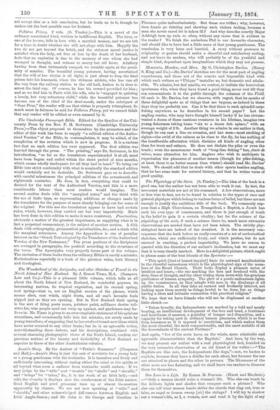The Physiology of the Sects. (S. Tinsley.)—The idea of the
book is a good one, but the author has not been able to work it out. In fact, the necessary materials are not at his command. A few observations, more or less true to fact, are to be found in relation to the types of race and general physique which belong to various forms of belief, but these are not enough to justify the ambitious title of the book. We commonly sup- pose that a High Churchman, an Evangelical, a Baptist, a Jesuit has each his own type of countenance, and there is just enough of truth in the belief to gain it a certain vitality ; but for the science of the physiology of the sects, if such a science there be, much more extensive observations are needed than have yet been taken. The strictly phy- siological facts are indeed of the scantiest. It is the necessary con- sequence that the book before us really consists of a set of ecclesiastical sketches, which are sufficiently lively, and which profess, but do not succeed in reaching, a perfect impartiality. We have no reason to quarrel with the direction of our author's ihclination, but we must say that it is very clearly marked. Here is a delightful picture, which ought to please some of the best friends of the Spectator :— " This spirit [that of honest inquiry] finds its outward manifestation in the cheerful earnestness which is the physiological sign of the mem- bers of the Broad Church.. Their looks display a pleasant union of intellect and heart,—the one marking the face and forehead with the deep lines of thought, and the other toning them down with the gracious gentleness of human sympathy. The glow of a poetic enthusiasm lights up the countenance, as they mingle with men in the discharge of all public duties. In all they take an earnest and brotherly interest, not looking upon them merely as things lawful to be done, but as things having a close and intimate connection with practical religion."
We hope that we have friends who will not be displeased at another little sketch :— " Taken broadly, the Independents are marked by a bold and manly bearing, an intellectual development of the face and head, a frankness and heartiness of manner, a geniality of temper and disposition, and a capacity for taking part in ordinary human pleasure; which is as free from looseness as it is opposed to asceticism, and which makes them the most cheerful, the most companionable, and the most sociable of all the descendants of the ancient Puritans."
And again, " few of the sects have, on the whole, more admirable and agreeable characteristics than the Baptists.' And here, by the way, we may present our author with a real physiological fact, founded on the very extensive observation of an old friend of the writer :—" The Baptists are like cats, the Independents like dogs,"—not, we hasten to explain, because they have a dislike for each other, but because the one are attached to places and the other to persons. The likenesses of the other sects are less flattering, and we shall leave our readers to discover
them for themselves.


































 Previous page
Previous page